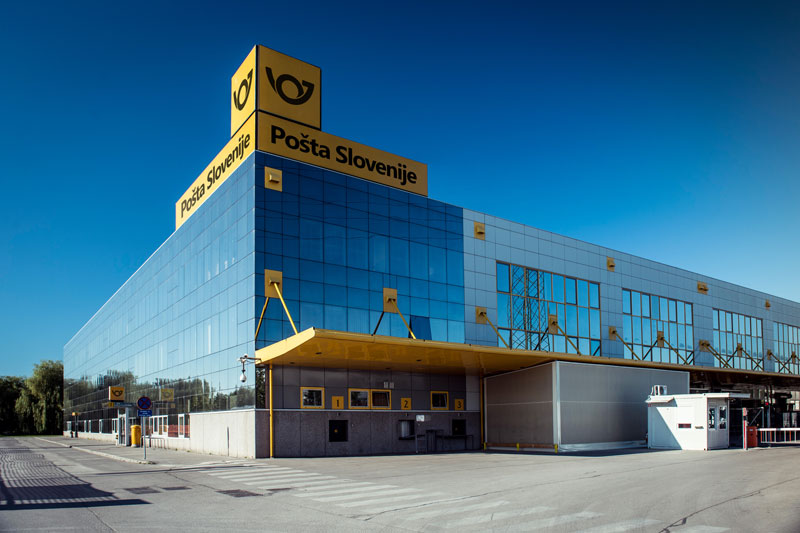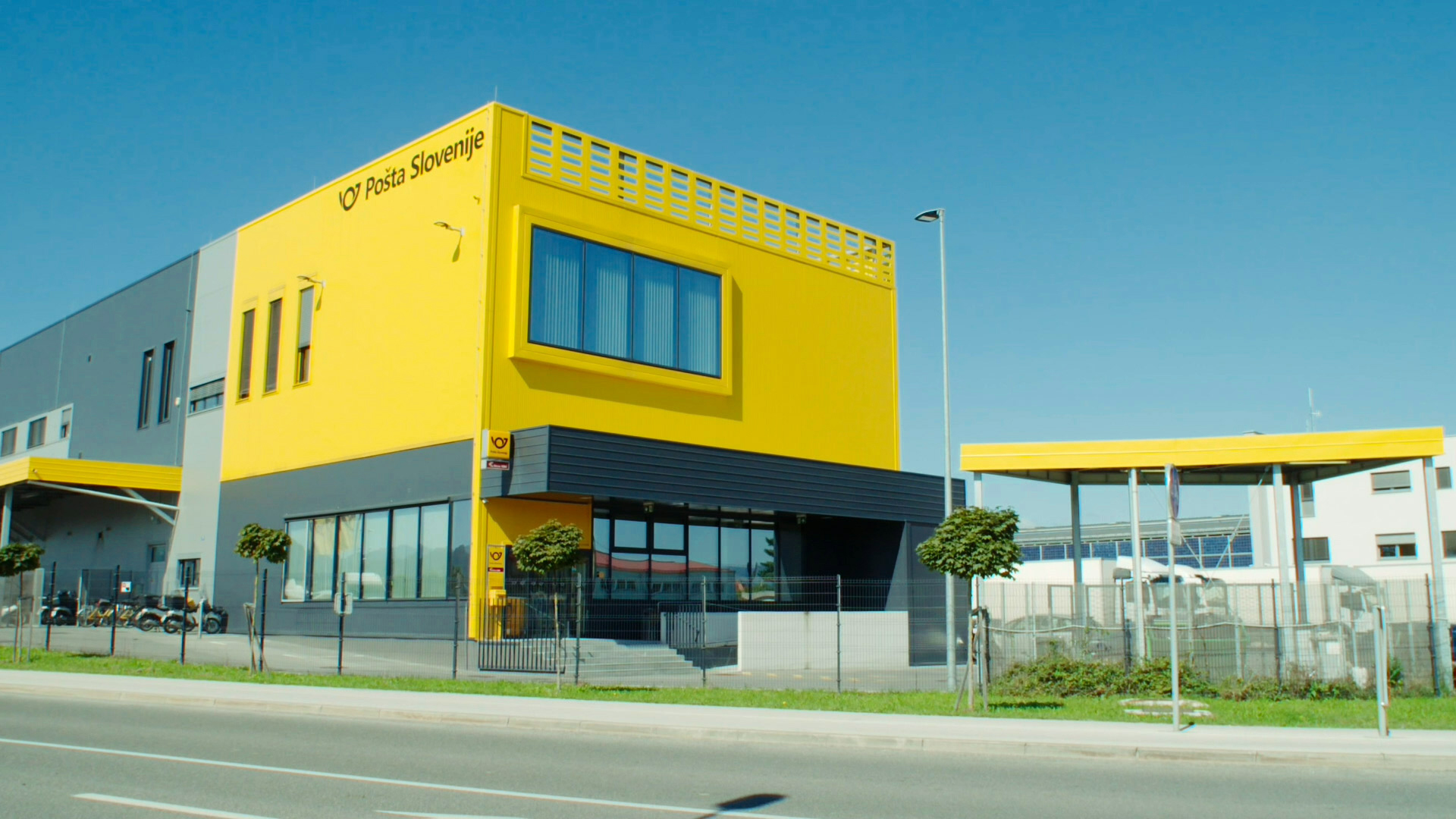what is the pilot about?
INTEGRATION OF ISOLATED POSTAL LOGISTICS NETWORKS ACROSS COUNTRY BORDERS THROUGH DIGITAL TOOLS
Postal logistics traffic between Slovenia and Croatia is characterised by large parcel volumes. However, postal operations pass through two exchange offices located in Ljubljana and Zagreb and largely depend on road transportation and pre-defined routes and schedules. Between the two countries, postal traffic from Slovenia is clearly larger than Croatia’s, mostly arriving from the North-East and predominantly destined for Zagreb.
Logistics networks so far operate separately, resulting in delayed information on, e.g. the number, weight and dimensions of shipments which makes it difficult to plan ahead and thus optimise warehouse processes.
Pilot site
In 2024, the volume of postal traffic between Slovenia and Croatia reflected an active and reciprocal exchange of different types of mail and parcels. Pošta Slovenije received a total of 120,064 letter-post items in P and G formats and 106,090 E-format items from Hrvatska pošta.
The P format typically refers to small letter-post items with dimensions and weight limits that qualify them as standard letters, while the G format includes larger letter-post items that may exceed the size of standard envelopes but still fall within the category of letter mail. Both are used primarily for documents and lightweight communications. The E format, on the other hand, is generally associated with tracked small packets, commonly used for lightweight e-commerce shipments that include goods rather than documents.
In addition to letter-post, 12,195 parcel items were received from Croatia under the Interconnect parcel delivery framework, which facilitates international parcel exchange between postal operators within the Universal Postal Union system.
On the outbound side, Pošta Slovenije sent 168,789 P and G format letter-post items to Croatia, along with 121,333 E-format items. Parcel shipments from Slovenia to Croatia totaled 51,490 Interconnect parcels in 2024.
Furthermore, in the previous year, Pošta Slovenije also received approximately 100,454 postcards from Croatia, corresponding to a total weight of around 640 kilograms. These figures highlight a steady flow of both traditional correspondence and growing cross-border e-commerce exchanges.
Who is involved?
- Pilot Partner / Post of Slovenia: National postal operator for Slovenia, responsible for pilot coordination and implementation of the logistics planning tool in first mile processes and the market place
- Pilot Partner / Post of Croatia / Locodel: responsible for pilot coordination and implementation of the logistics planning tool in last mile processes and the market place, specialized in urban same-day and last-mile delivery
- Scientfic Support / University of Ljubljana: Slovenias higher education and scientific research institution. UL leads project activities focusing on analyzing current business models and assessing the potential for new business models. Setting up elevation metrics for implementation.
- Logistics Planning Tool / Solvesall: Slovenian digital solutions company that specializes in logistics optimization and AI solutions. Develop a logistics planning ztool that will accommodate the pilots needs and connect different logistics networks
Challenges
Which difficulties wants this pilot to solve?
1. Market pressure from customers, that increasingly demand greener solutions and predictive CO₂ reporting
- Drivers: Large e-commerce and industrial clients now expect logistics partners to track and minimize emissions, especially Scope 3 (indirect emissions).
- Challenge: Current systems do not provide automated or predictive CO₂ emission tracking, which weakens Pošta Slovenije’s and partners’ ability to:
- Comply with upcoming EU sustainability regulations.
- Prove and market their green logistics credentials.
- Enable informed procurement decisions by clients based on environmental impact.
- Result: Competitive disadvantage in tenders and B2B relationships with climate-conscious clients.
2. Unused potential for increasing efficiency: inability to plan optimal delivery/pick-up routes or consolidate shipments efficiently across borders
- Problem: Each stakeholder (Pošta Slovenije, Croatian Post, transporters, e-commerce clients) plans routes independently, leading to:
- Duplicated or overlapping delivery trips.
- Partially loaded vehicles crossing borders.
- Uncoordinated pick-ups and drop-offs in the same area.
- Lack of shared infrastructure or planning tools prevents cross-border route optimization, consolidation of loads, and intelligent scheduling.
- Consequence: Increased costs, emissions, and missed opportunities for collaboration.
3. Redundant routing through Ljubljana’s exchange office, causing extra distance, costs, and emissions
- Current flow: Many parcels from northeastern Slovenia destined for Zagreb must first go through Ljubljana for consolidation.
- Inefficiencies:
- Adds an extra leg to the journey, increasing kilometers traveled and fuel consumption.
- Delays delivery times due to unnecessary routing.
- Increases labour and handling costs at the Ljubljana hub.
- Solution needed: Direct routing (e.g., Celje → Zagreb) supported by smarter planning and digital handover protocols.
4. Isolated logistics networks between Slovenian and Croatian stakeholders with no shared digital system
- Situation: Every party operates on their own IT systems with no interconnection or data exchange.
- Challenges:
- No coordinated visibility of parcel flows or capacity across networks.
- Inability to synchronize transport schedules, consolidate shipments, or manage exceptions jointly.
- Manual communication (email, phone) needed for every step of coordination.
- Impact: High administrative burden, missed consolidation opportunities, slower reaction to disruptions.
5. Lack of real-time shipment data (volume, weight, dimensions, destination), hindering workforce and transport planning
- Problem: Essential information about shipments is either:
- Unavailable in advance, or
- Received too late to plan efficiently.
- Effects:
- Transshipment warehouse staff cannot prepare for incoming loads (e.g., allocate manpower, space).
- Transport managers cannot adjust vehicle types or optimize loading based on real data.
- Load factor suffers, and vehicles are often underutilized or misallocated.
- Underlying cause: Absence of standardized digital interfaces and real-time data exchange between logistics actors.

Objectives
What drives the pilot activities?
The main aim is to optimise cross-border postal logistics between Slovenia and Croatia by establishing a green corridor to facilitate more efficient and sustainable exchanges. This involves integrating tools for route optimisation, emissions tracking and digital marketplace interactions.
- Increasing competitiveness by improving postal logistics operations will create additional collaborative opportunities in demand redistribution.
- Connecting the currently separate delivery networks of Slovenian and Croatian Post by optimising routes in a more environmentally friendly way.
- Enable direct shipping routes, reduce unnecessary trips and lower emissions
- Increase vehicle load factors through pre-trip visibility of shipment characteristics
- Provide buyers of logistics services with transparent emission data and service quality metrics via the ADMIRAL Marketplace to make informed procurement choices
- Implement the logistics planning tool as a digital environment that not only plans but also offers services to outside stakeholders (open market access) for seamless collaboration and scalability
approach & SOLUTIONS developed
HOW TO REDUCE EMISSIONS & OPTIMISE PROCESSES?
- Develop cross-border logistics/transport planning tool linking logistics network members
- Integrate logistics planning tool into separate business networks thus establishing marketplace dynamics and offering easier access to outside players
- Include transparency and sustainability rating of services portfolio
- Shipment data, as well as data on demand and supply of cargo space and transportation is used as data basis
- Data gained through the LOPTA will empower the emission calculator
- Deploy Crowdsourcing tool for improved order management and last mile operations

expected outcomes
- Coordinated cross-border logistics framework through digital tools and services
- Information on all demand and supply dynamics, shipment qualities and quantities and logistics resources via logistics planning tool
- Optimized route planning, cargo occupancy and harmonization of demand
- Informed procurement of (sustainable) logistics services by end users
- Open market possibilities for transport services provision and network connectivity including external stakeholders
- Improved load factor by 20%
- Reduced CO2 emissions per package distribution by 25%
- Improved operational efficiency in last mile processes
- Reduced transport costs from Slovenia to Croatia by 30 %
COLLABORATION WITH OTHER PILOTS
The Slovenian and Lithuanian pilots collaborated closely on the setup and alignment of CO2 calculation methodologies to ensure GLEC compliant methodologies for postal-logistics operations within the pilots and ADMIRAL marketplace.


